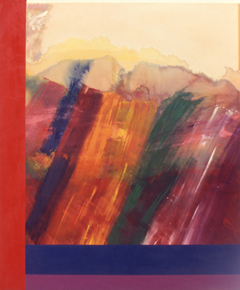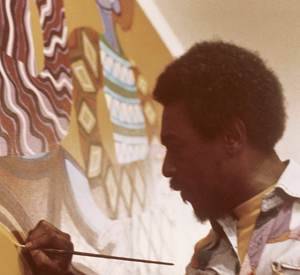Work
Ausby worked in a variety of mediums, including canvas, sculpture, stained glass, and performance art. He often worked with traditional African forms and palettes. Many of his paintings, such as Meditation in Blue, employ the style of Hard-edge painting. Some of his later art, such as his work in stained glass, reflect the sensibilities of the Pattern and Decoration movement. [5]
He was heavily inspired by the music of Sun Ra, and in the late 1970s began his series of geometric experimentation paintings titled Space Odyssey, named as such to reflect this connection to Sun Ra’s afrofuturist philosophies. He would continue to work on the series for several years. As time went on, Ausby began to incorporate more three-dimensional elements into his work, mixing substances such as sawdust into his paint in order to create more textured works and incorporating relief elements which extended off the surface of the canvas. He often used unstretched canvas in his work, which would be attached directly to gallery walls and other structural supports to create dynamic three-dimensional shapes for exhibition.
In 1978 and 1979, Ausby received artist grants through the Cultural Council Foundation Artists’ Project, which was funded under the Comprehensive Employment and Training Act. Through these grants, Ausby was able to direct the multimedia performance piece InnerSpace/OuterSpace, which was performed in Union Square and at the Museum of Natural History, New York and incorporated projections of his paintings and sculptures. [6] In 2005, Ausby was commissioned by the MTA to design the stained glass piece Space Odyssey, which is now installed at the Marcy Avenue station in Williamsburg, Brooklyn.

His Meditation in Blue (1998), a geometric abstraction in acrylic, is housed in the Saint Louis Art Museum permanent collection. [7]
Ausby's work has been shown in both solo and collective exhibitions.
| Year | Exhibition Title | Institution | Notes |
|---|---|---|---|
| 1969 | New Black Artists [8] | Brooklyn Museum | |
| 1970 | Unknown [6] | Cinque Gallery | First solo exhibition. Gallery now closed. |
| 1970 | Afro-American Artists, New York and Boston [9] | Museum of Fine Arts, Boston | |
| 1971 | Some American History [10] | Rice University Institute for the Arts, Houston | Commissioned by the Menil Foundation. |
| 1971 | Contemporary Black Artists in America [6] | Whitney Museum of American Art, New York | |
| 1972 | Ellsworth Ausby and James Phillips: Paintings [11] | Peale House Galleries, Pennsylvania Academy of the Fine Arts | |
| 1980 | Afro-American Abstraction [12] | MoMA PS1 | First “Space Odyssey” polyptych displayed. |
| 2021 | Ellsworth Ausby: Somewhere in Space, Paintings from the 1960s and 1970s [6] | Eric Firestone Gallery |
Related Research Articles
Abstract expressionism in the United States emerged as a distinct art movement in the immediate aftermath of World War II and gained mainstream acceptance in the 1950s, a shift from the American social realism of the 1930s influenced by the Great Depression and Mexican muralists. The term was first applied to American art in 1946 by the art critic Robert Coates. Key figures in the New York School, which was the center of this movement, included such artists as Arshile Gorky, Jackson Pollock, Franz Kline, Mark Rothko, Norman Lewis, Willem de Kooning, Adolph Gottlieb, Clyfford Still, Robert Motherwell and Theodoros Stamos among others.

Monochromatic painting has played a significant role in modern and contemporary Western visual art, originating with the early 20th-century European avant-gardes. Artists have explored the non-representational potential of a single color, investigating shifts in value, diversity of texture, and formal nuances as a means of emotional expression, visual investigation into the inherent properties of painting, as well as a starting point for conceptual works. Ranging from geometric abstraction in a variety of mediums to non-representational gestural painting, monochromatic works continue to be an important influence in contemporary art.

Morris Louis Bernstein, known professionally as Morris Louis, was an American painter. During the 1950s he became one of the earliest exponents of Color Field painting. While living in Washington, D.C., Louis, along with Kenneth Noland and other Washington painters, formed an art movement that is known today as the Washington Color School.

Color field painting is a style of abstract painting that emerged in New York City during the 1940s and 1950s. It was inspired by European modernism and closely related to abstract expressionism, while many of its notable early proponents were among the pioneering abstract expressionists. Color field is characterized primarily by large fields of flat, solid color spread across or stained into the canvas creating areas of unbroken surface and a flat picture plane. The movement places less emphasis on gesture, brushstrokes and action in favor of an overall consistency of form and process. In color field painting "color is freed from objective context and becomes the subject in itself."
Paul Jenkins was an American abstract expressionist painter.
Shaped canvases are paintings that depart from the normal flat, rectangular configuration. Canvases may be shaped by altering their outline, while retaining their flatness. An ancient, traditional example is the tondo, a painting on a round panel or canvas: Raphael, as well as some other Renaissance painters, sometimes chose this format for madonna paintings. Alternatively, canvases may be altered by losing their flatness and assuming a three-dimensional surface. Or they can do both. That is, they can assume shapes other than rectangles, and also have surface features that are three-dimensional. Arguably, changing the surface configuration of the painting transforms it into a sculpture. But shaped canvases are generally considered paintings.

Ellsworth Kelly was an American painter, sculptor, and printmaker associated with hard-edge painting, Color field painting and minimalism. His works demonstrate unassuming techniques emphasizing line, color and form, similar to the work of John McLaughlin and Kenneth Noland. Kelly often employed bright colors. He lived and worked in Spencertown, New York.

Sam Gilliam was an American abstract painter, sculptor, and arts educator. Born in Mississippi, and raised in Kentucky, Gilliam spent his entire adult life in Washington, D.C., eventually being described as the "dean" of the city's arts community. Originally associated with the Washington Color School, a group of Washington-area artists that developed a form of abstract art from color field painting in the 1950s and 1960s, Gilliam moved beyond the group's core aesthetics of flat fields of color in the mid-60s by introducing both process and sculptural elements to his paintings.
Leon Polk Smith (1906–1996) was an American painter. His geometrically oriented abstract paintings were influenced by Piet Mondrian and he is a follow er of the Hard-edge school. His best-known paintings constitute maximally reduced forms, characterized by just two colors on a canvas meeting in a sharply delineated edge, often on an unframed canvas of unusual shape. His work is represented in many museums in the United States, Europe, and South America. Thanks to a generous bequest from the artist, the Brooklyn Museum has 27 of his paintings on permanent display.

Ronnie Landfield is an American abstract painter. During his early career from the mid-1960s through the 1970s his paintings were associated with Lyrical Abstraction, and he was represented by the David Whitney Gallery and the André Emmerich Gallery.
Joe Bradley is an American visual artist, known for his minimalist and color field paintings. He is also the former lead singer of the punk band Cheeseburger. Bradley has been based in New York City and Amagansett.
Cordy Ryman, an artist based in New York City. Ryman earned his BFA with Honors in Fine Arts and Art Education from The School of Visual Arts in New York in 1997. He is the son of artist Robert Ryman (1930-2019). Cordy Ryman is represented by Freight and Volume Gallery, New York, NY.
Sanford Biggers is an American interdisciplinary artist who works in film and video, installation, sculpture, music, and performance. A Los Angeles native, he has lived and worked in New York City since 1999.

Miya Ando is an American visual artist recognized for her paintings, sculptures, and installation artworks that address concepts of temporality, interdependence, and impermanence. Ando's artworks have been exhibited in museums, galleries, and public spaces worldwide.

Ted Stamm (1944–1984) was an American minimalist and conceptualist artist.

Carl Randall is a British figurative painter, whose work is based on images of modern Japan and London.
Charles Hinman born 1932 in Syracuse, New York is an Abstract Minimalist painter, notable for creating three-dimensional shaped canvas paintings in the mid-1960s.
Joe Wesley Overstreet was an African-American painter from Mississippi who lived and worked in New York City for most of his career. In the 1950s and early 1960s he was associated with the Abstract Expressionist movement.

Charles Robert Searles was an African American artist born in Philadelphia in 1937. He studied at the Pennsylvania Academy of Fine Arts and was active from the 1960s until he died in 2004 from complications from a stroke.
Jamillah James is an American curator. She is the Manilow Senior Curator at the Museum of Contemporary Art Chicago.
References
- ↑ "Gerald Jackson by Stanley Whitney - BOMB Magazine". bombmagazine.org. Retrieved 2021-10-23.
- ↑ Boyd, Herb (2016-09-29). "Griot and culinary anthropologist Vertamae Smart-Grosvenor passes at 79". New York Amsterdam News. Retrieved 2021-10-23.
- ↑ "Jamillah Jennings - Artists - Eric Firestone Gallery". www.ericfirestonegallery.com. Retrieved 2021-10-23.
- ↑ "Exhibitions". New Museum Digital Archive. Retrieved 2021-10-23.
- ↑ "Ellsworth Ausby". The New Yorker. Retrieved 2021-10-23.
- 1 2 3 4 "Ellsworth Ausby: Somewhere in Space, Paintings from the 1960s and 1970s - 40 Great Jones Street | New York, NY - Exhibitions - Eric Firestone Gallery". www.ericfirestonegallery.com. Retrieved 2021-10-23.
- ↑ "Meditation in Blue". Saint Louis Art Museum. Retrieved 2021-10-23.
- ↑ "Brooklyn Museum". www.brooklynmuseum.org. Retrieved 2021-10-23.
- ↑ Times, Hilton Kramer Special to The New York (1970-05-22). "Black Artists' Show On View in Boston". The New York Times. ISSN 0362-4331 . Retrieved 2021-10-23.
- ↑ "Diaspora-artists: View details". new.diaspora-artists.net. Retrieved 2021-10-23.
- ↑ "History of the Peale House Gallery Exhibitions (1964-1978) · PAFA's Digital Archives". pafaarchives.org. Retrieved 2021-10-23.
- ↑ "Afro-American Abstraction | MoMA". The Museum of Modern Art. Retrieved 2021-10-23.